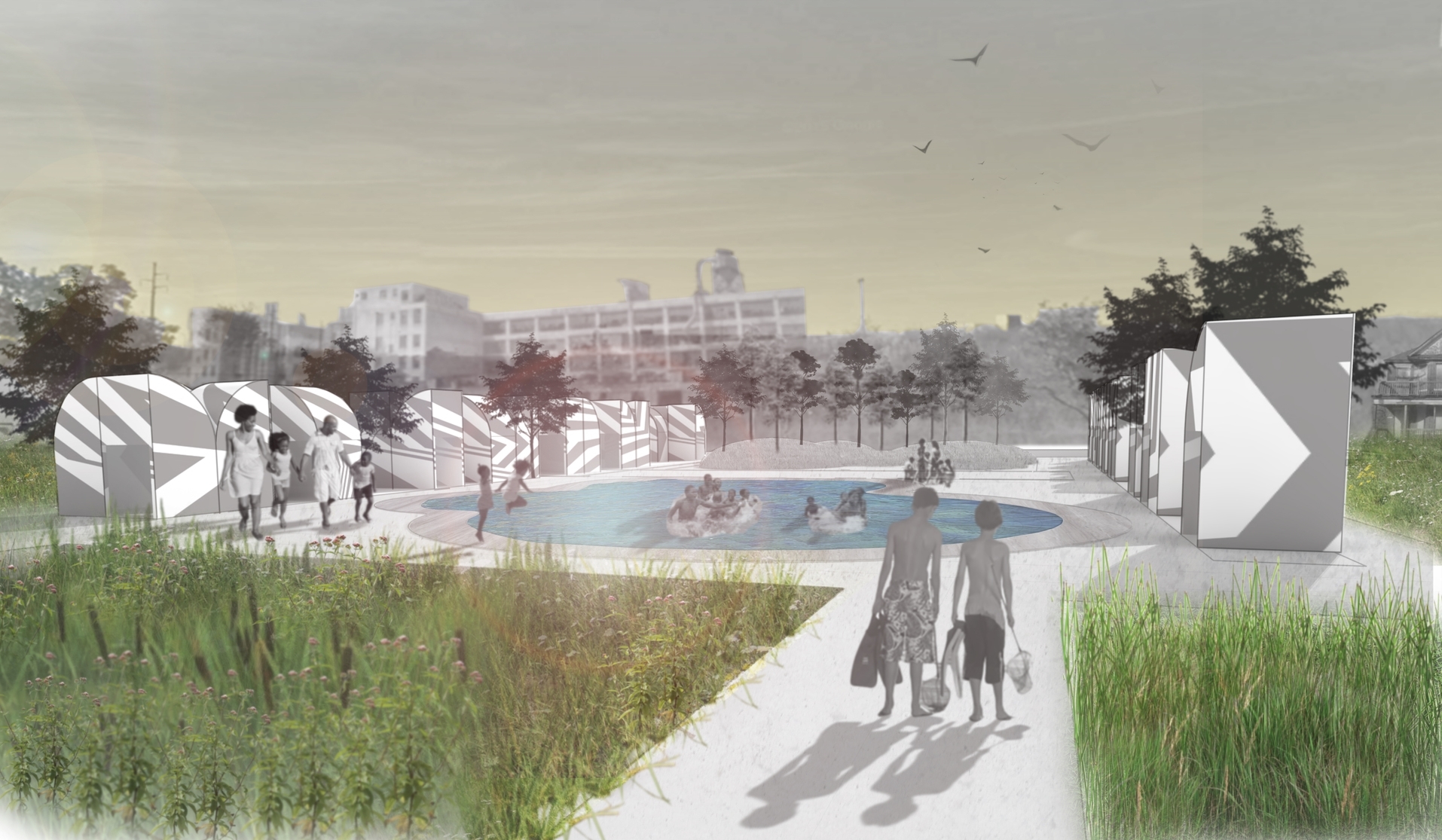“Dip and Dive in the D” explores the potential of introducing natural pools as a low cost, healthy and sustainable alternative to conventional pools for Detroit’s neighborhoods.
Natural pools use plants and bio filters to clean the water, don’t use any chemicals, they are more affordable to build and maintain than conventional pools. As they don’t need to be drained at the end of the season and they use less water and can be used for iceskating during the winter months.
The project proposes four different designs that address different challenges of operating municipal pools in the city that were identified during our research and conversations with people from the Health Department, Recreational Department or the DEQ in Lansing .
The vignettes operate on different scales and speculate aboutdifferent ownership models, the engagement of different stakeholders but as well address the constraints of local codes that are regulating the operation of public pools.
1. The guerilla pond
The guerilla pond is a DIY natural swimming pool using low cost materials and material readily available in the local hardware store. The construction and details follow David Butler’s hand boook. Butler, 2015
This small pond can be build on a private lot with the help of friends or neighbors. Using the foundation of an existing building after demolition of the superstructure makes the pool building process manageable. The existing foundation can be altered to accommodate a smaller size pool through the construction of CMU block walls. Plants can be either bought at a local store or could be as well sourced from near by natural waterscapes in the northern Metro Area.
This typology can be built throughout the city and the knowledge to build this pool could be communicated through the “Field Guide to Working with Lots” of Detroit Future City. Greening of Detroit could assist with choosing the right plants, teaching how to maintain an ecologically balanced pond environment and conduct annual pond inspections.
2. The QUILTED pool
The quilted pool redefines the municipal neighborhood pool as a space for public engagement and community effort. It links public and private investment but as well skills and knowledge of community organizations and local residents. The pool is operated by a neighborhood organization with the support of the Parks and Recreation department and local stakeholders such as schools, churches and Non-profit organizations. These are involved in the maintenance of the natural landscape, the training of lifeguards, providing swim lessons but as well benefit from the pool as extension of their own facilities. This pool serves as a location where neighbors can meet during summers and it engages residents of all ages to contribute to the construction but as well successful operation of their community pool.
3. the swim hole
The swim hole links swimming in natural waters with prospective necessary blue-infrastructure projects. It speculates on optimizing and intensifying urban infrastructure to accommodate storm water management but as well maximizing the benefit for the community of these large public investments. The swim hole is planned and operated in conjunction with required remediation systems that accommodate storm water runoff and downspout disconnections of large industrial facilities on the city’s east side. The overlay of uses couples private and public investments and might qualify for additional funding through the variety of technical, social and cultural performance. The project operates two separate water circulation systems: bioswales and technical wetlands manage stormwater runoff and clean the water before it feeds the natural pool system. Storage tanks increase the capacity of the system.
4. the swimming Pier
The swimming pier creates a safe environment to swim in the Detroit River. It is constructed as a floating jetty and can land in several locations at the Riverfront. The water quality of the Detroit River north of West Riverfront Park is typically safe for swimming and the current will be slowed down by the structure of the bath to enable swimming. The water circulation in the non-swimmer and wading area is additionally controlled by pumps and a sand filter. After heavy rainfall the pier might be closed until the water quality has been tested and evaluated as safe for swimming. Changing rooms and bathrooms are located on the pier. The access is free to the public and lifeguard service and access control is provided by the Department for Parks and Recreation. River baths are very affordable (ca. $750,000) to build and come with very low maintenance cost.
All four design proposals place the following essential resources at the center of their project: public space and water. They all share the intention to optimize and intensify the use of existing either natural, social and infrastructural resources of the city and to increase the access and benefit for the residents. “Dip ‘n’ Dive in the D” is interested in defining a design attitude that enables a multiplicity of uses of public and private infrastructure. Rather than proposing projects that rely on the availability of one funding source, it speculates on the mix and overlap of necessary infrastructure with public amenities informing synergetic design solutions. Thesecreate a simultaneity of nature and the urban, the present and the past and redefine the community pool as a new way to appropriate public space.
The project embraces Detroit’s diverse landscape of strong neighborhood and community engagement and intends to link it with public and private investment to reintroduce the neighborhood pool as collaborative platform that invites the city’s residents to a new, engaged form of democratic participation.












